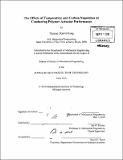The effects of temperature and carbon nanotubes on conducting polymer actuator performance
Author(s)
Keng, Yenmei
DownloadFull printable version (17.22Mb)
Other Contributors
Massachusetts Institute of Technology. Dept. of Mechanical Engineering.
Advisor
Ian W. Hunter.
Terms of use
Metadata
Show full item recordAbstract
Conducting polymers serve as electrically conductive actuators via ion diffusion in and out of the polymer when voltages are applied. Their actuation performance can be largely affected by deposition setup, post-deposition processing, type of electrolyte, applied voltage for actuation, and temperature. It was shown that increasing temperature caused higher active stress in polypyrrole, an attractive conducting polymer actuator material. However, detailed characterizations were lacking to determine whether the improved active stress was caused by structural change in the polymer and/or charging effect. A temperature-controlled solvent bath was integrated with a custom-built electrochemical dynamic mechanical analyzer to conduct isometric and isotonic tests on polypyrrole under elevated temperature. Experimental results showed that heating increased the charge transport through the polymer and thermal expansion in the polymer allowed more room for charge uptake. As a result, increase in ion movement largely contributed to improvements in actuation stress (rate) and strain (rate), while the decrease in stiffness due to heating had limited effect. Moreover, actuation performance was further improved by choosing large active ion type, BMIM. Although the active stress and strain increased via heating, creep limits the reversibility of conducting polymer actuators. To reduce creep rate, functionalized multi-walled carbon nanotubes (fCNTs) were introduced to fabricate composites with polypyrrole and with PEDOT. Out of four attempted fabrication techniques, drop-casted multilayer structure demonstrated that increasing the amount of fCNTs reduced creep rate, but also decreased active strain, stiffness, and conductivity. Applying higher preload (up to 3 MPa) improved active strain in the composites by providing more space for charge uptake. The amount of sCNTs that provided optimal performance was approximately 20-30% by weight.
Description
Thesis (S.M.)--Massachusetts Institute of Technology, Dept. of Mechanical Engineering, 2010. Cataloged from PDF version of thesis. Includes bibliographical references (p. 102-103).
Date issued
2010Department
Massachusetts Institute of Technology. Department of Mechanical EngineeringPublisher
Massachusetts Institute of Technology
Keywords
Mechanical Engineering.